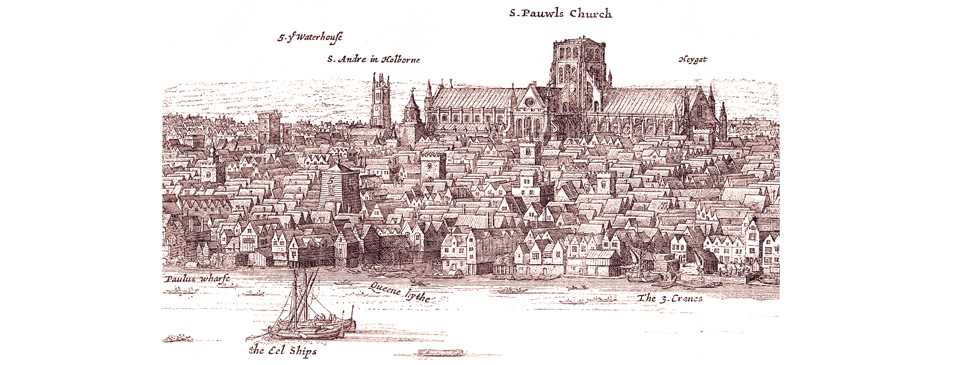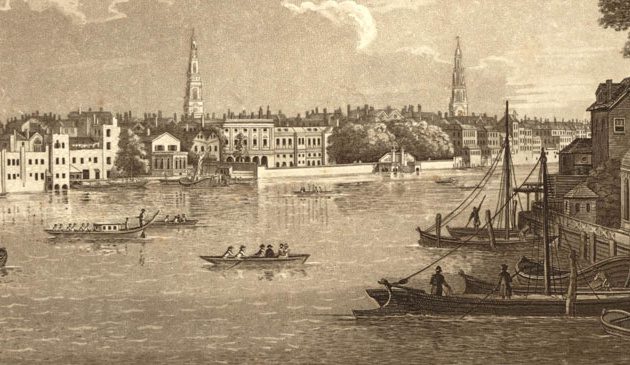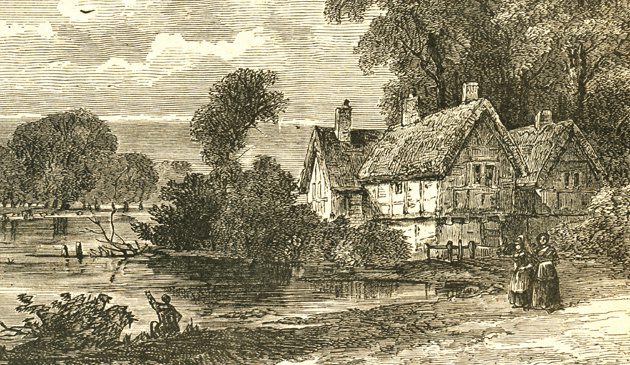Wenceslaus Hollar

A section of Hollar’s famous Long View of London, originally produced as a five-metre long panorama of the city, it is a bird’s-eye view from above the church of St.Mary Overie in Southwark. He etched it while in exile in Antwerp, probably based on earlier sketches made in London, leading to several small inaccuracies. It was published in 1647 and dedicated to Princess Mary, niece of Charles II and the future Queen Mary II.
It is relatively easy to have a good understanding of certain aspects of 17th century London, partly thanks to the artist Wenceslaus Hollar. His pictures or their derivatives are more famous these days than the man himself, often seen on printed material depicting ‘old London’ of the time.
Wenceslaus (or Vaclav) Hollar was born in Prague in 1607, at that time the capital of Bohemia, into a middle-class family, his father a lawyer and court bureaucrat. Hollar began sketching miniatures and maps in his youth. It was in his hometown that he learnt the skills of copper engraving and the new technique of etching in which more subtle graduations of tone and texture can be achieved. He additionally produced minute detail in his works – such as hair or fur – by hand-engraving onto a plate that he had already etched.
The 20-year old Wenceslaus left Prague and spent several years travelling around what is now Germany, and during 1634 lived in Antwerp, everywhere filling sketchbooks with illustrations. By 1636 he was in Cologne, a city of rich merchants where he was probably able to obtain commissions for work. At that same time Thomas Howard, Earl of Arundel, was passing through the city with his entourage. Part of the English royal court, Arundel was en-route to the Holy Roman Emperor in Vienna on a diplomatic mission on behalf of Charles I. He invited Hollar to join his party to record the journey in pictures. The group travelled up the Rhine, through war-torn areas of Germany, back through the Lowlands and on to London, Hollar sketching as they went.
Howard lived at Arundel House on the Strand between London and Westminster and close to the royal palace at Whitehall. He was one of the great connoisseurs and collectors of antiquities of his time, a patron of the artists Peter Paul Rubens and Anthony Van Dyke, both of whom he had attracted to London. Hollar arrived in a country of peace and tranquillity compared with those he had left behind and London a town not too dissimilar to his boyhood home of Prague. At what was a small Tudor palace filled with works of art and an open-house to artists and writers, it is not difficult to understand the attraction to the young man of remaining in the city on Arundel’s staff, probably working in return for food, lodging and clothing. (He produced two etchings of Arundel House showing the inner courtyard and surrounding buildings).
Hollar soon began to make drawings of his adopted homeland and his first published work here was a ‘long-view’ of the tranquil countryside, looking towards London from what is now Greenwich Park. On the left stands the old Duke Humphrey’s Tower (the site of the later Royal Observatory) on the hill, with the new Queen’s House and old riverside Tudor palace to the right.
During his first six years Hollar worked on drawings for a catalogue of his collection that Arundel intended to publish. It was during that period that he filled his sketch-books with drawings of London that would eventually find their way into print in later years. At the same time he began producing work for publication. There was a growing number of merchants, gentry and aristocrats – such as the men who formed the Royal Society – with an interest in purchasing books for the knowledge they contained and they were published by various printers based around or close to St. Paul’s Cathedral. Pictures started to appear in both books and as individual prints and the country’s first major publisher of prints was Peter Stent at the ‘sign of the White Horse’ beside the River Fleet. It was he who began publishing prints of work by Hollar.
While working at Arundel House Hollar made the acquaintance of Lady Arundel’s lady-in-waiting Margaret. In 1641 they were married. The country was moving towards civil war and in that year Hollar drew his well-known picture of the execution at the Tower of London of the Earl of Strafford and later one of the trial of Archbishop Laud. In 1642 King Charles fled Whitehall. The Earl of Arundel sent much of his collection to Antwerp while he went into exile in Italy, leaving his London home to be trashed by Parliamentary troops. He died in Padua in 1644. For Hollar six happy and productive years at Arundel House were at an end. In 1644, with the Civil War at its height, Hollar moved with his family across the North Sea to Antwerp.


